My Spicy Beef Ramen Recipe
My spicy beef ramen recipe is a hearty and soul-warming slow cooker ramen that’s easy to make and incredibly flavorful.
Slow-cooked to perfection, this dish features tender chunks of chuck roast infused with the aromatic essence of ginger, onion, garlic, cinnamon, and homemade sriracha. We pair the tender beef with an irresistible broth made from beef, coconut water, and peanut butter (weird, I know, but trust me).
These elements harmonize to create a savory, deliciously spicy, sweet ramen.
The humble chuck roast undergoes a remarkable transformation in this recipe, becoming succulent, melt-in-your-mouth morsels that complement the soft and slurp-worthy ramen noodles. The slow cooker is your secret weapon, effortlessly infusing every ingredient with the full depth of flavor.
Whether you’re a ramen lover or a newcomer to this beloved Japanese dish, prepare to be wowed by the ease and authenticity of this Spicy Beef Ramen. It’s a hearty, belly-warming creation that’s bound to become a household favorite.

Slow Cooker Spicy Beef Ramen Ingredients
Here are all the ingredients you need to make this delicious spicy beef ramen:
- 3-5 pounds chuck stew meat
- 8 cups beef broth
- 1-quart coconut water
- 1/3 cup tamari or soy sauce
- 4 tablespoons fermented sriracha
- 1/4 cup creamy peanut butter
- 2 yellow onions, minced
- 6 cloves garlic, minced
- 1 tablespoon fresh ginger, peeled and minced
- 2 bay leaves
- 1 cinnamon stick
- 5 cups bok choy, chopped
- dry ramen noodles
- fresh green onions
- Cilantro
- Soft boiled eggs
Equipment you need (one of the following):
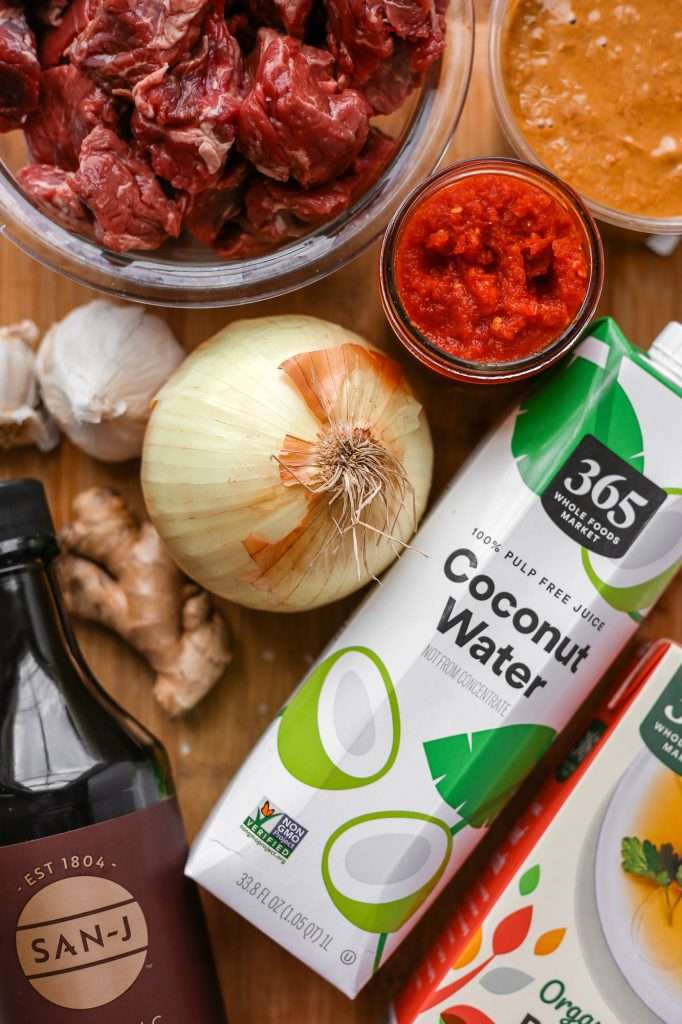
The History of Ramen Noodle Soup
Ramen, the beloved Japanese noodle soup, boasts a storied history as diverse as its flavorful variations.
While its precise origin is somewhat debated, it’s widely believed that ramen’s roots lie in China. Chinese immigrants introduced wheat noodles to Japan in the late 19th century, influencing the development of what we now know as ramen.
The first documented appearance of ramen in Japan was at a Chinese restaurant in Yokohama in the early 20th century. Initially, it was a Chinese specialty, but it rapidly evolved into a Japanese culinary icon. The dish was trendy among students and workers for its affordability and hearty nature.
Throughout the 20th century, ramen experienced a culinary transformation, adapting to Japanese tastes and regional preferences. Various regions in Japan developed their distinctive styles of ramen, resulting in an exciting array of flavors and ingredients.
Some of the notable regional variations include:
- Shoyu Ramen: Originating in Tokyo, this ramen features a clear, soy sauce-based broth, often paired with thin, curly noodles and toppings like seaweed, green onions, and char siu (roasted pork).
- Miso Ramen: Hailing from Hokkaido, this ramen incorporates a rich and hearty miso (fermented soybean paste) broth, offering a unique umami flavor. People often serve this ramen with corn, butter, and bean sprouts.
- Tonkotsu Ramen: A specialty of Kyushu, this ramen features a creamy, pork bone-based broth that’s simmered for hours. It’s accompanied by thick, straight noodles garnished with pickled ginger and garlic.
- Shio Ramen: A lighter, salt-based ramen popular in various regions of Japan, known for its simple, delicate broth and a range of toppings, including seafood, vegetables, and more.
- Tsukemen: This style involves dipping cold noodles into a rich, concentrated broth, offering a unique and intense ramen experience.
In recent years, ramen has become a global sensation, with chefs and home cooks putting their unique twists on this iconic dish worldwide.
From the bustling streets of Tokyo to trendy ramen shops in New York City, ramen’s enduring appeal lies in its adaptability. It’s so adaptable that you can even make slow cooker ramen.

Slow Cooking Chuck Roast for Spicy Beef Ramen
When we subject tough cuts of beef to moisture and slow cooking at a low temperature for an extended period, we can transform chewy and unappetizing protein to tender, succulent, and intensely flavorful meat. This culinary magic is primarily due to the breakdown of collagen, a tough connective tissue found in these cuts. When exposed to prolonged, gentle heat, collagen gradually converts into gelatin, which imparts the desired tenderness and a luxurious mouthfeel to the meat.
In addition to tenderization, slow cooking allows the beef to absorb and infuse with the flavors of the cooking liquid and seasonings, resulting in a rich, complex flavor. The low and slow approach preserves the meat’s natural juices, ensuring it remains moist and flavorful throughout the cooking process.
This cooking method is ideal for cuts like chuck roast, brisket, or short ribs, turning them into delectable, melt-in-your-mouth protein. So, whether crafting a hearty pot roast or simmering beef in a ramen broth, slow cooking at a low temperature is the key to elevating tough cuts into delicious cuisine.

Slow Cooker Ramen Variations
I love using chuck roast stew meat in this slow cooker ramen since it is cost-effective. However, you can use other affordable cuts of beef that are perfect for slow cooker ramen.
The best cuts of beef for slow cooking are typically those with higher collagen content and more rigid fibers, as these cuts benefit the most from the long, gentle cooking process that breaks down the collagen into gelatin, resulting in tender, succulent meat.
Here are some of the top choices for slow cooking:
- Chuck Roast: This is the classic choice for pot roast, stew, or braised dishes. It’s marbled with fat and rich in collagen (ideal for slow cooking). The result is fall-apart tender meat that’s incredibly flavorful.
- Brisket: Often used for barbecue, brisket’s tough nature makes it perfect for slow cooking. It turns into a smoky, melt-in-your-mouth delight when cooked low and slow.
- Short Ribs: These are well-suited for slow braising and slow cooker ramen. Whether bone-in or boneless, they become tender and packed with flavor after hours of cooking.
- Shank: Beef shank is an excellent choice for hearty, slow-cooked soups and stews. The marrow-rich bone adds a robust flavor to the dish.
- Round Roast: The round roast, from the cow’s rear leg, is lean and can be tough. Slow cooking helps break down the toughness, resulting in a delicious roast.
- Skirt or Flank Steak: While not as tough as some other cuts, they benefit from slow cooking for fajitas, tacos, or other dishes, as it helps them become tender and absorb flavors.
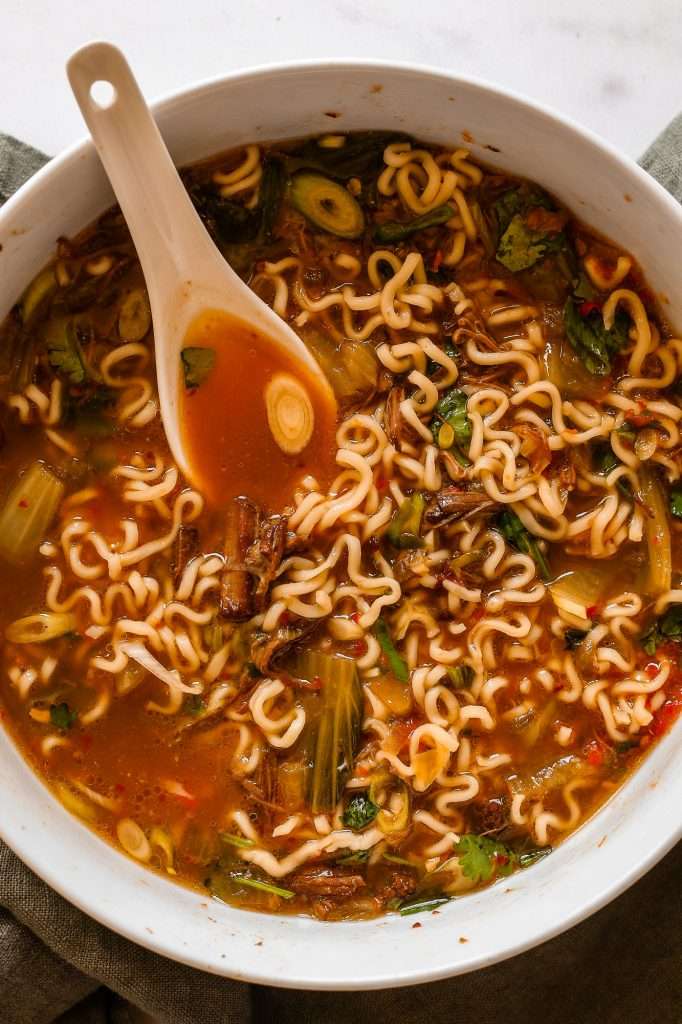
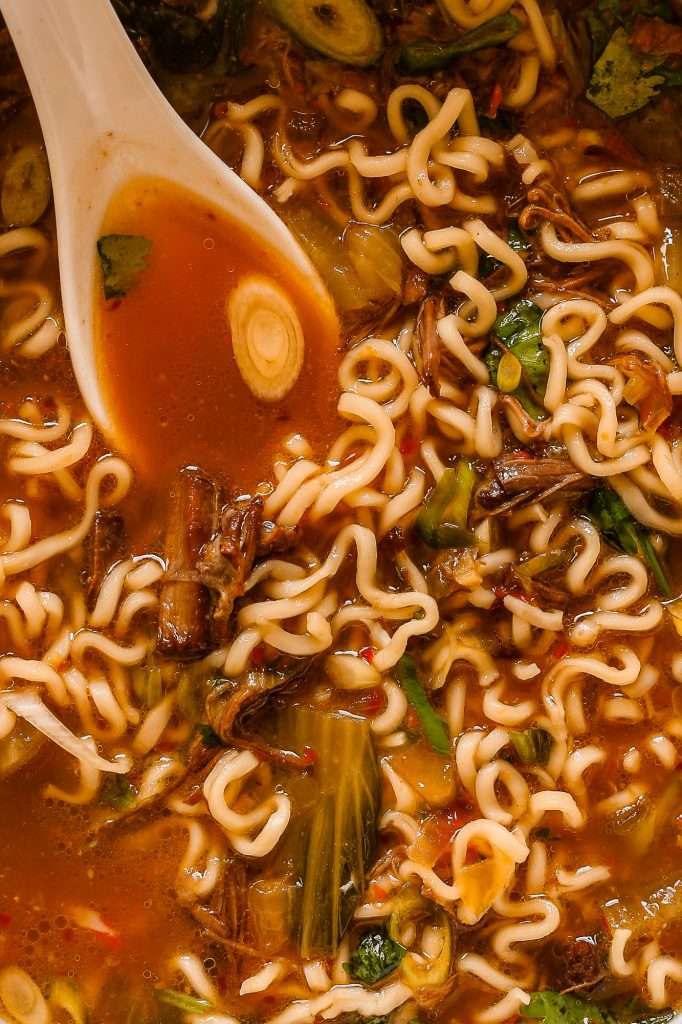
More Soup Recipes to Try
- Creamy Chicken Ramen Slow Cooker Recipe
- Lime Chili Shrimp Ramen with Nourishing Coconut Broth
- Authentic Cajun Seafood Gumbo with Crab, Shrimp and Mussels
- Creamy Roasted Carrot Soup with Ginger and Miso
- Thai Red Curry Ramen with Coconut Milk and Cilantro
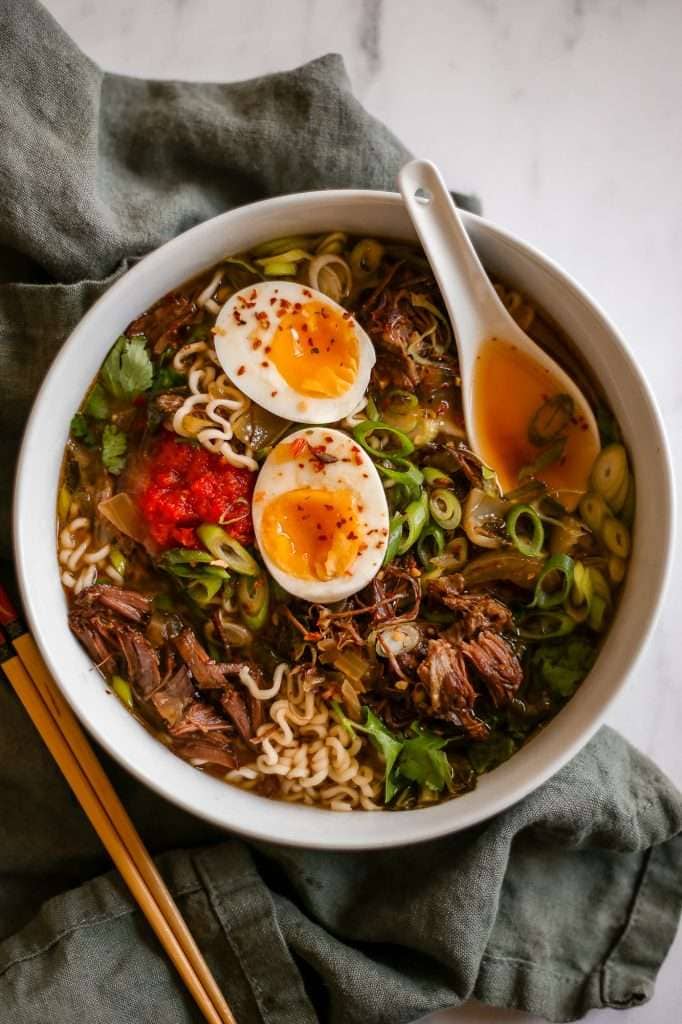
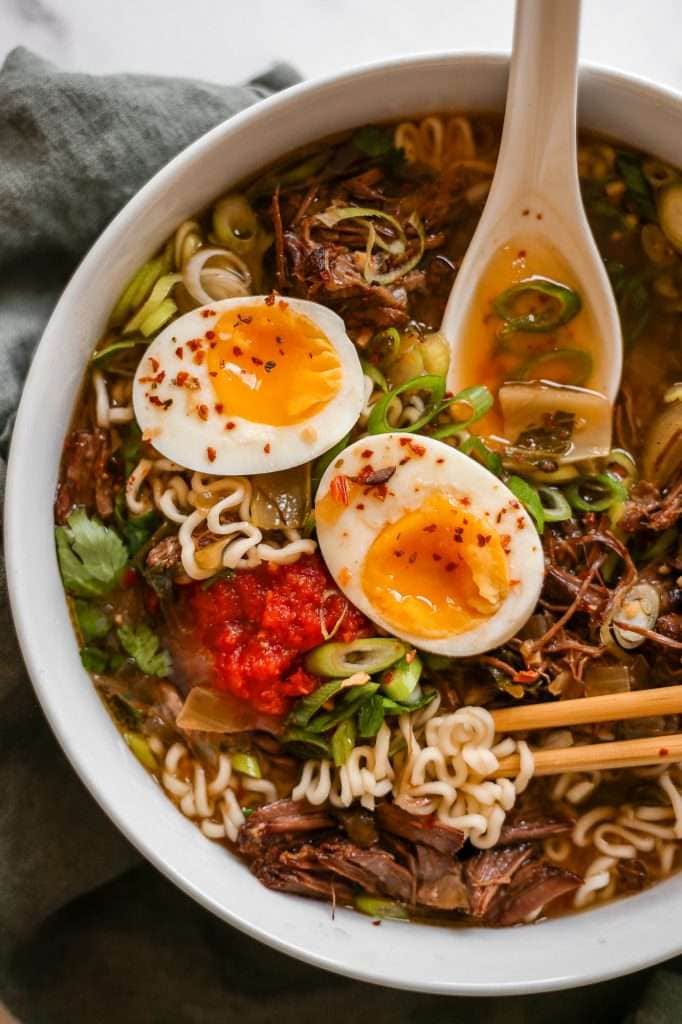
Slow Cooker Spicy Beef Ramen Made with Chuck Roast
An easy recipe for spicy beef ramen made from scratch and slow-cooked to perfection. This is a slow cooker ramen made with chuck stew meat, but you can use other beef cuts in this recipe. You can also use this recipe with an instant pot or on the stovetop (directions for all methods are included).
- Prep: 45 minutes
- Cook: 6 hours
- Total Time: 6 hours 45 minutes
Ingredients
- 3 pounds chuck stew meat
- 8 cups beef broth
- 1-quart coconut water
- 1/3 cup tamari or soy sauce
- 1/4 cup fermented sriracha
- 1/4 cup creamy peanut butter
- 2 yellow onions, minced
- 6 cloves garlic, minced
- 1 tablespoon fresh ginger, peeled and minced
- 2 bay leaves
- 1 cinnamon stick
- 5 cups bok choy, chopped
- dry ramen noodles
- fresh green onions, chopped
- Cilantro, chopped
- Soft boiled eggs
Instructions
crockpot
- Pat the chuck stew meat dry with a paper towel and season well with salt and pepper. In a skillet over medium high heat, sear the meat on all sides.
- Add the seared meat in the bowl of the crockpot. Add the sriracha, peanut butter, onion, garlic, ginger, bay leaves, and cinnamon stick. Pour over the broth, coconut water, and tamari. Cover and cook on low for 6-8 hours or on high for 4-6 hours.
- Remove the cinnamon stick and bay leaves from the broth. The meat should break apart easily with a fork.
- Increase the heat on the slow cooker to high. Stir in the bok choy, and cook uncovered for about 5 minutes.
- Taste the broth and add salt and more sriracha to taste if necessary.
- Add your noodles to a heat-safe bowl, and top with boiling water. Let the noodles soak until soft then drain.
- To make soft boiled eggs, bring water to a boil then boil eggs for 7-8 minutes. Immediately place the eggs in an ice water bath. Allow them to chill completely before peeling.
- Ladle the broth with meat and bok choy into bowls with the noodles.
- Top with cilantro, green onions, soft boiled eggs, more hot sauce, and sesame seeds. Serve immediately.
Stove
- Pat the chuck stew meat dry with a paper towel and season well with salt and pepper. In a skillet over medium high heat, sear the meat on all sides.
- Add the seared meat to a large stock pot with a lid. dd the sriracha, peanut butter, onion, garlic, ginger, bay leaves, and cinnamon stick. Pour over the broth, coconut water, and tamari. Cover and cook on low for 6-8 hours.
- Remove the cinnamon stick and bay leaves from the broth. The meat should break apart easily with a fork.
- Increase the heat to a simmer. Stir in the bok choy, and cook uncovered for about 5 minutes.
- Taste the broth and add salt and more sriracha to taste if necessary.
- Add your noodles to a heat-safe bowl, and top with boiling water. Let the noodles soak until soft then drain.
- To make soft boiled eggs, bring water to a boil then boil eggs for 7-8 minutes. Immediately place the eggs in an ice water bath. Allow them to chill completely before peeling.
- Ladle the broth with meat and bok choy into bowls with the noodles.
- Top with cilantro, green onions, soft boiled eggs, more hot sauce and sesame seeds. Serve immediately.
Instant Pot
- Pat the chuck stew meat dry with a paper towel and season well with salt and pepper.
- Turn the instant pot to sauté, and once hot, add the stew meat. Sear on all sides.
- Add the sriracha, peanut butter, onion, garlic, ginger, bay leaves, and cinnamon stick. Pour over the broth, coconut water, and tamari.
- Seal the lid and cook on high pressure for 50 minutes. Allow the pressure to release naturally (about 1 hour)
- Remove the cinnamon stick and bay leaves from the broth. The meat should break apart easily with a fork.
- Turn the heat back to sauté. Stir in the bok choy, and cook uncovered for about 5 minutes.
- Taste the broth and add salt and more sriracha to taste if necessary.
- Add your noodles to a heat-safe bowl, and top with boiling water. Let the noodles soak until soft then drain.
- To make soft boiled eggs, bring water to a boil then boil eggs for 7-8 minutes. Immediately place the eggs in an ice water bath. Allow them to chill completely before peeling.
- Ladle the broth with meat and bok choy into bowls with the noodles.
- Top with cilantro, green onions, soft boiled eggs, more hot sauce and sesame seeds. Serve immediately.
















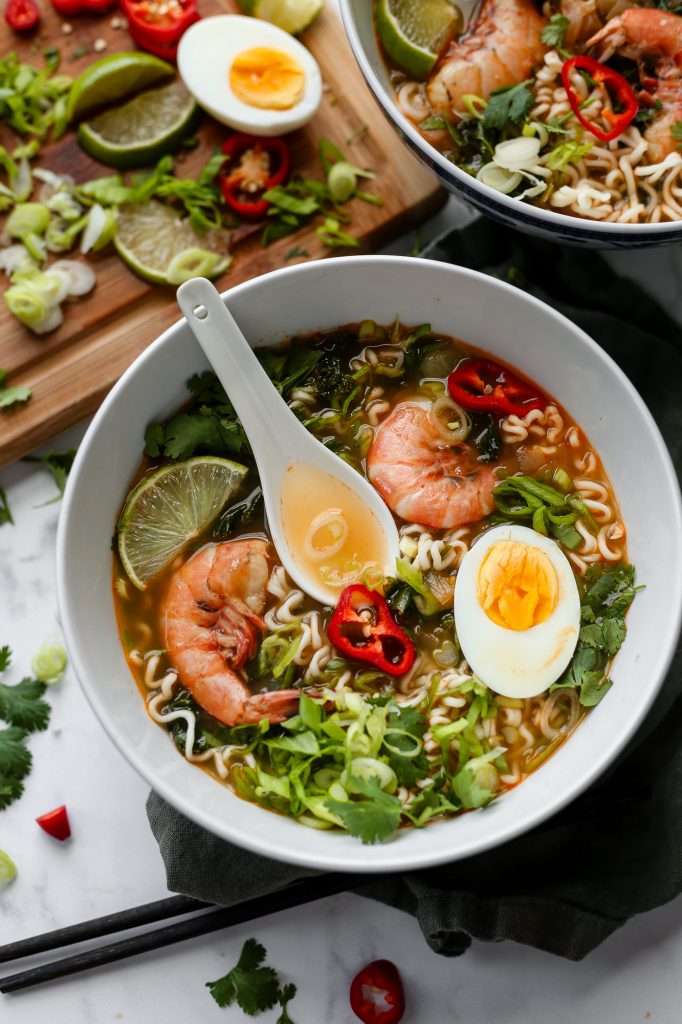

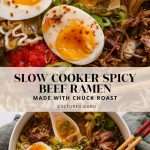
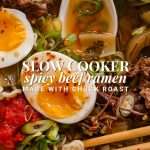
This sounds delicious. I have one question, though. What is the quantity of dry ramen noodles in ounces, for the 8-10 servings?
dry ramen noodles usually come in little “bricks” that are either 1 or 2 servings, so you’ll need 8-10 of those.
I’m always looking for creative ways to do chuck roast because we get bored of the same old…. I saw this recipe and gave it a try – SO GOOD! The whole family loved it, will definitely be on regular rotation. I added some sliced mushrooms since we had them on hand which was a fun addition!
Just made this recipe tonight ( minus the cilantro) and it was fantastic!! Even my husband, who is not a soup fanatic like me, loved it and said it was definitely a “keeper”. So glad there are leftovers.
Sidney texted me and told me how much you love this one! I’m so happy you tried it!
This was absolutely fantastic! Reminded us of the ramen we get in Hawaii.